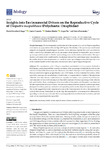Insights into Environmental Drivers on the Reproductive Cycle of Diopatra neapolitana (Polychaeta: Onuphidae)

Use this link to cite
http://hdl.handle.net/2183/32302Collections
- Investigación (FCIE) [1227]
Metadata
Show full item recordTitle
Insights into Environmental Drivers on the Reproductive Cycle of Diopatra neapolitana (Polychaeta: Onuphidae)Date
2022-10-14Citation
Escobar-Ortega, D.; Couceiro, L.; Muíño, R.; No, E.; Fernández, N. Insights into Environmental Drivers on the Reproductive Cycle of Diopatra neapolitana (Polychaeta: Onuphidae). Biology 2022, 11, 1504. https://doi.org/10.3390/biology11101504
Abstract
[Abstract] The reproductive cycle of Diopatra neapolitana was studied over two years in Redondela (NW Spain), considering both the monthly evolution of the percentage of individuals with oocytes and the variation of the mean oocyte size. Moreover, since three other species of Diopatra have recently been documented in regions geographically close to NW Spain, we first confirmed the identity of this species by carrying out a morphological identification of a representative number of the specimens collected. Our data showed a discontinuous reproductive season, with a period of proliferation and maturation of oocytes from January to September and asynchronous spawning events between July and October. Then, a resting period in the months of November and December was observed. We also explored the influence of some relevant environmental factors (namely, water temperature, photoperiod, salinity, primary production and upwelling index) on the observed reproductive cycle. The results suggest that water temperature is one of the most important drivers of the reproductive cycle for this species. Particularly, in Ría de Vigo, the reproductive cycle seems to be influenced by upwelling events of deep cold water that occur frequently between March and September, and that could act as a spawning-inducing switch.
Keywords
Taxonomy
Bristle worm
Reproduction
Galicia
Maturation cycle
Bristle worm
Reproduction
Galicia
Maturation cycle
Description
Data are available in a publicly accessible repository: https://doi.org/10.5281/zenodo.7081249 (accessed on 14 September 2022).
Editor version
Rights
Atribución 4.0 Internacional
ISSN
2079-7737






